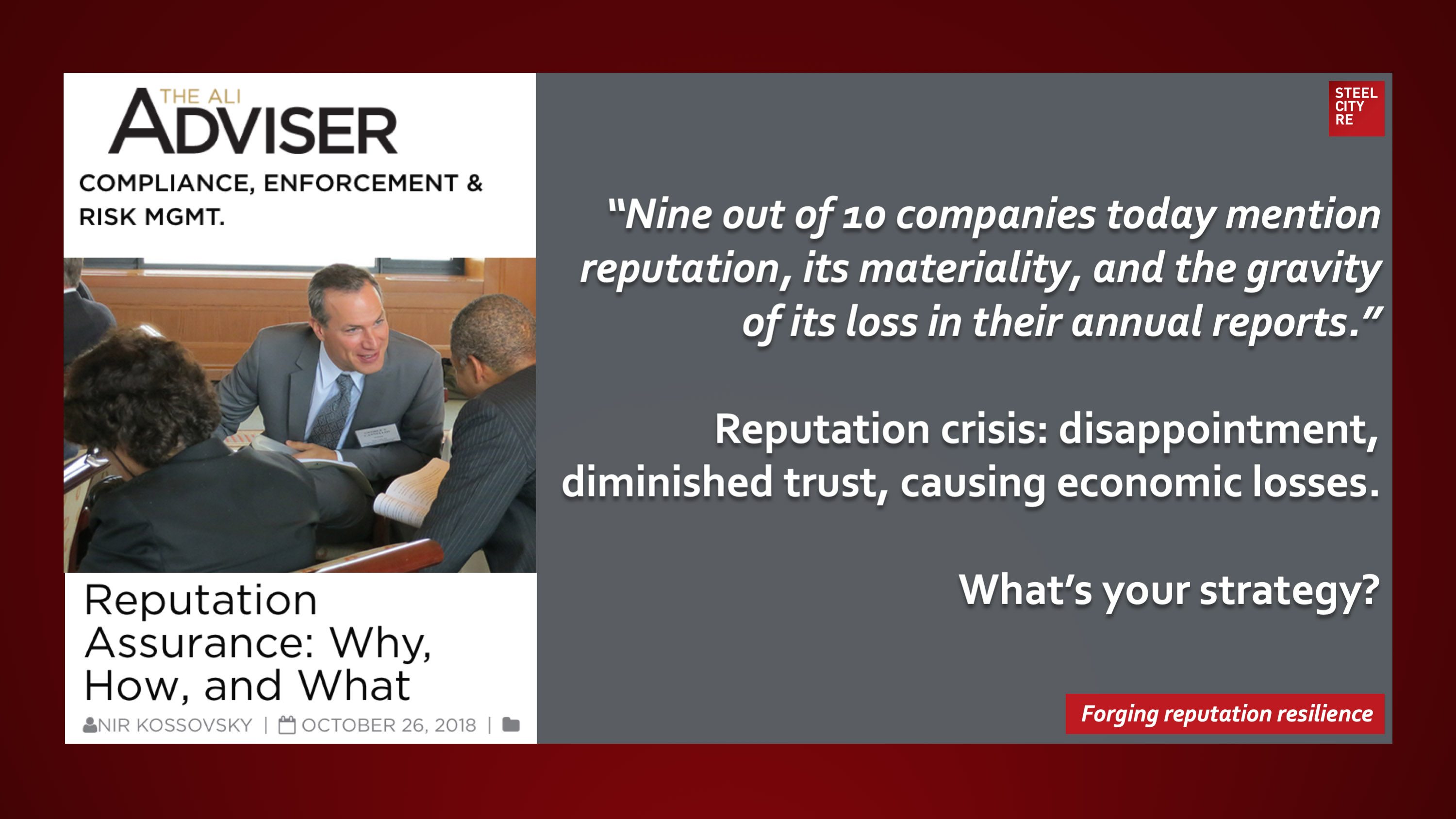Reputation value is measurable and therefore it is manageable and insurable. In an attempt to help companies manage and insure that value, Steel City Re has compiled this Solution Executive Summary .
In fact, most companies still mistakenly confuse reputation with public opinion. It can be a very costly misunderstanding. The media amplifies the crisis once it is set in motion, but it is not the cause of a loss in reputational value.
Reputation risk is a material peril of economic harm from angry disappointed stakeholders. It is the gap between those stakeholders’ expectations and the reality of their experience with any given entity. Nine out of 10 companies today mention reputation, its materiality, and the gravity of its loss in their annual reports. But very few detail the steps they are taking to mitigate the risk, leaving themselves and their boards in the position of setting expectations (they recognize the risk), but then disappointing stakeholders when an incident occurs by their failure to have employed appropriate mitigation strategies.
October 27, 2018
American Law Institute Adviser
On reputation risk from ALI Adviser, the blog of the The American Law Institute , “the leading independent organization in the U.S. producing scholarly work to enforce and uphold the law.”
“Nine out of 10 companies today mention reputation, its materiality, and the gravity of its loss in their annual reports.”
Reputation crisis: disappointment, diminished trust, causing economic losses.
Reputations are valuable strategic intangible assets. Threats to these assets⏤ enterprise reputation risks, often mislabeled “brand risks” ⏤ need to be managed, and management needs to be overseen through reputation risk governance lest reputational damage or reputational harm result in long-tailed go-forward losses in economic value and/or political power. Because these intangible risks arise from the interplay of stakeholder expectation, experiences, and media amplification, parametric insurances for intangible asset risks, for reputational value, for reputational harm, and for reputation assurance help mitigate risk by telling a simple, convincing and completely credible story of quality reputation governance to stakeholders. This story telling effect is the expressive power of insurance complementing insurance’s better known instrumental power of indemnification.
Reputation is Mission-Critical
Mitigating the Hazards of ESG-Linked Enterprise Risk. A management program for ethics and compliance can forestall prosecution and mitigate fines. Similarly, oversight of “mission- critical” issues can forestall securities litigation. A program for reputation resilience, comprising both risk management and insurance (reinsurance)-authenticated oversight for all that is mission-critical, can create value in many ways. To this end, Steel City Re offers a Reputation Resilience Program.
Having a robust Reputation Resilience Program in place offers, amongst other benefits:
- Protection for the company, its staff, executives, and board from litigation and regulatory challenges
- Improved governance processes and better enterprise risk management protocols; i.e., measuring reputational risk
- Establishment of an agile operating, communications, and decision-making team, with clear roles and responsibilities, trained and ready to handle all reputational threats; i.e., a reputation risk management framework
- Proactive management of risks that could give rise to delays or derailing concerns around new product and strategic partnership launches
- Captured behavioral economic value from stakeholders; i.e., value of reputation
- Reduced costs of debt and risk transfer while boosting equity value; i.e., boosting reputational value
A hazard of reputation risk is a lurking gap between stakeholder expectations and reality. Another hazard is the emotional intensity associated with expectations. The peril is anger from disappointed stakeholders. This video and this written summary explain the behavioral economic features of the many perils of reputation risk.
Mitigating risk strategically through expectation management and operational adjustments evinces thoughtful management and dutiful governance. Financing such risks evinces prudence, and doing so publicly enables stakeholders to appreciate and value the effort. These comprise the core of Steel City Re’s professional services.
One Question
Mitigating the Hazards of ESG-Linked Enterprise Risk. ESG-linked reputation risks are prevalent and material. Are reinsurance and insurance for ESG-linked reputation risk part of your strategy?

